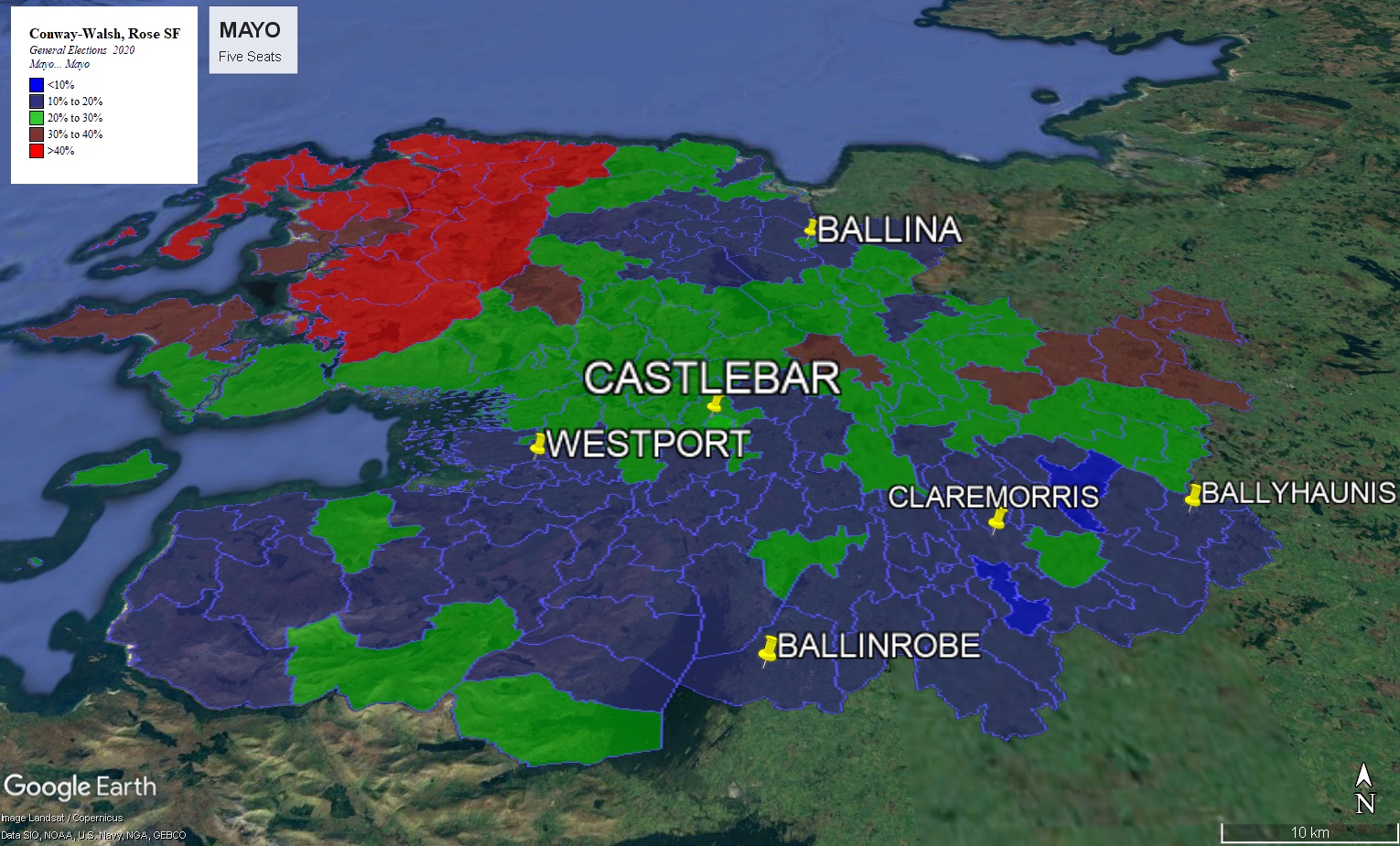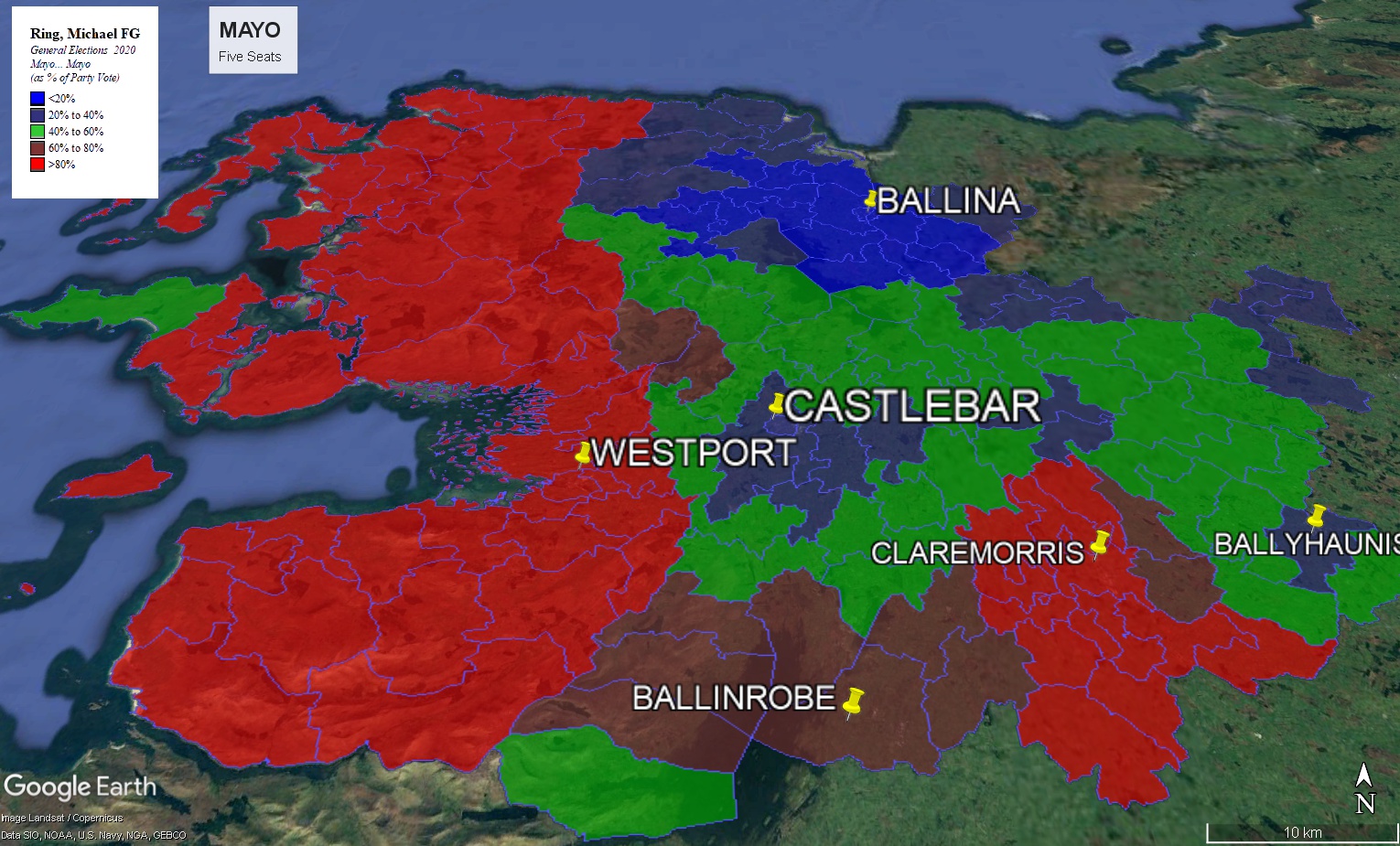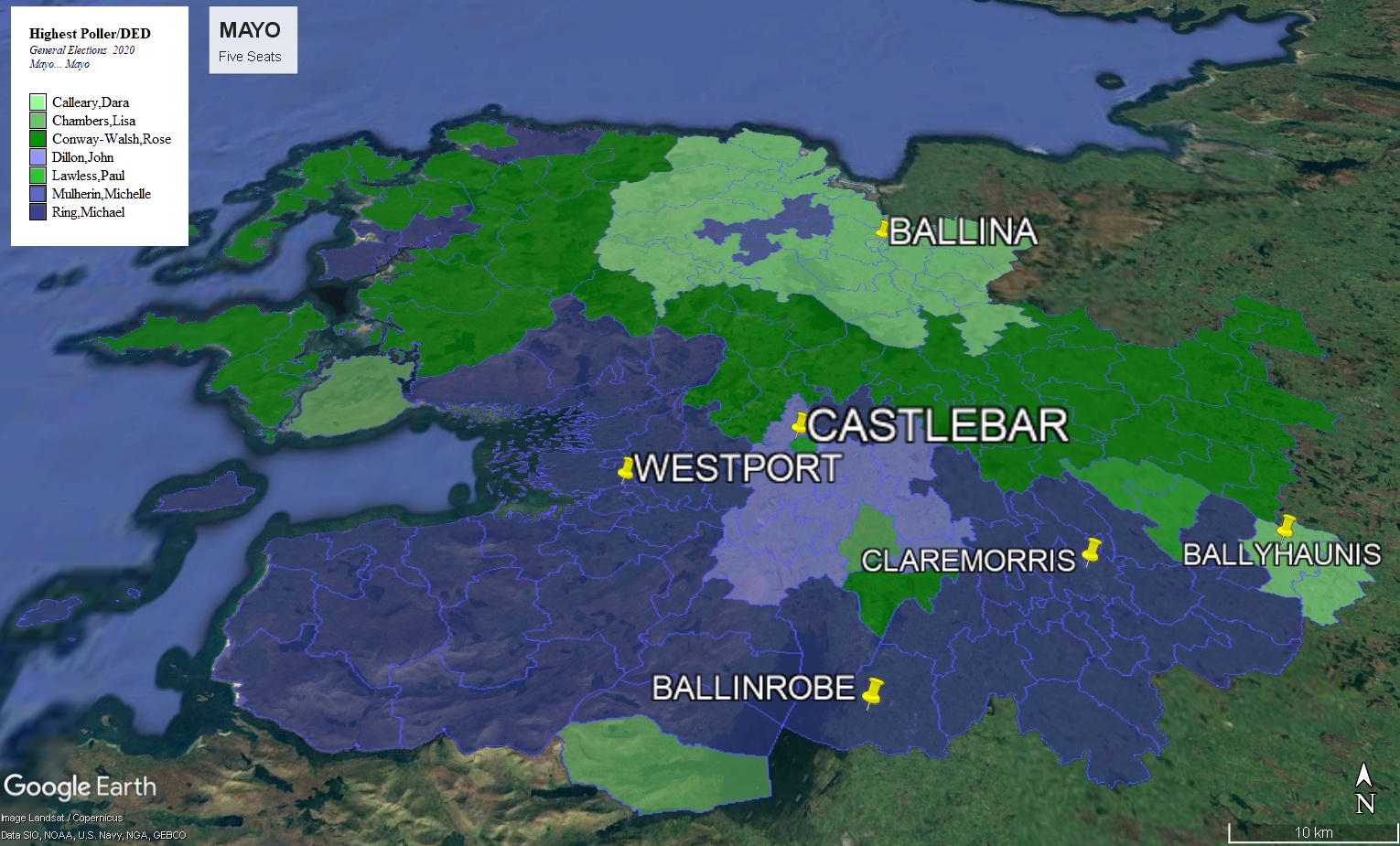Mayo becomes a five-seater with the return of the Ballinrobe hinterland from Galway West.
Between 1923 and 1969, the constituency was divided into two constituencues, Mayo North and Mayo South.
Mayo North was one of the five constituencies that returned a rump Sinn Féin candidate in June 1927. It also hosted Republican Tom Maguire (1921 until 1927) who in 1986 gave his blessing to Republican Sinn Fein in the aftermath of the Republican schism of that year; he died in 1993 at the age of 101.
Fianna Fáil held two out of three seats from 1937 until 1951 when Thomas O’Hara took a seat for Clann Na Talmhan on his third attempt. He held it in 1954 but lost in 1957 – he then won as a Fine Gael TD in 1965 and 1969 (for Mayo East). Joseph Leneghan ran unsuccessfully for Fine Gael in 1944 and 1951 before winning a seat in as an Independent in 1961 – he lost in 1965 but was elected again in 1969 this time for Fianna Fáil. In 1965 Fine Gael took two out of three seats for the first time; they took 49% just behind Fianna Fáil on 49.7%.
In Mayo South, Cumann na nGaedhal won three out of seats in 1923 – they lost one to Thomas O’Connell of Labour in June 1927 who topped the poll. In 1933 the first four candidates on the first count were Fianna Fáil, and the other four were Fine Gael. Between 1932 and 1943 the result was three seats for Fianna Fáil and two seats for Fine Gael – this pattern was broken in the latter year by the emergence of Clann Na Talmhan who won two seats. Fine Gael lost their seat in 1944, and failed to regain it until Henry Kenny (father of Enda) won it back for them.
In 1969 two new three seat constituencies of Mayo East and Mayo West were introduced. Fine Gael won two seats that year in Mayo East, and in 1973 won two seats in Mayo West – despite Fianna Fáil winning over half the vote. Otherwise each constituency returned two Fianna Fáil and one Fine Gael TDs until their abolition after 1992.
Fine Gael were dominant in the new five seat constituency winning three seats in 1997 and 2007 and four seats in 2011.
THE BIGGEST PARTIES PER DED IN 2020

The largest town in the constituency is Castlebar, situated in the centre of the county. The other sizeable town is Ballina to the town. Smaller towns include Westport, Ballinrobe and Claremorris.
Fine Gael topped the poll across much of the constituency, with Fianna Fáil topping the poll in Ballina, Sinn Féin in the rural north-west and – somewhat quixotically – Aontu in Knock.
VOTE BY SETTLEMENT TYPE
| AREA TYPE | PROP | FF | FG | SF | OTH | INDS |
| URBAN | 29% | 25 4% | 39.6% | 19.9% | 14.1% | 1.0% |
| RURAL | 71% | 24.4% | 39.5% | 23.9% | 10.9% | 1.2% |
Mayo differs from many other constituencies in that there is little difference in support between Urban and Rural areas for parties. In fact Sinn Fèin did better in rural areas than they did in urban – this was probably largely due to Rose Conway-Walsh’s personal support in the largely rural north-west.
The Sinn Féin transfers are worth having a look at for two reasons – firstly, for the important role that they played in ensuring Fianna Fáil took the last seat from Fine Gael in 2016 and secondly that over 40% of transfers in 2020 went to Fianna Fail and Fine Gael candidates in 2020 and only 18% to left-wing candidates.
The following are the statistics for the Sinn Féin transfers between 2002 and 2020. NT stands for Non-Transferable. Note that in 2020 the transfers are from a surplus – in the other years the transfers are from elimination.
SINN FEIN TRANSFERS 2002-2020
| YEAR | FF | FG | LEFT | OTHS | IND | NT |
| 2020 | 28.5% | 13.5% | 18.2% | 32.0% | 7,8% | |
| 2016 | 49.8% | 8.8% | 41.4% | |||
| 2011 | 13.7% | 18.2% | 26.2% | 14.9% | 27.0% | |
| 2007 | 20.5% | 25.5% | 38.8% | 15.3% | ||
| 2002 | 37.4% | 21.2% | 33.6% | 7.8% |
A further note is that Beverly Cooper-Flynn – formerly of Fianna Fáil – ran as an Independent. If her transfers had been included with those of Fianna Fáil, their transfer figure would have been around 40%.
In 2016, Sinn Féin transfers were important in ensuring that Fianna Fáil took the last seat from Fine Gael – FF took over five times as many Sinn Féin transfers as their civil war adversaries. In 2020, Fianna Fáil took over twice as many transfers as the sole left-wing candidate (Joe Daly of People Before Profit) – quite possibly the only constituency where this was the case.
One of the interesting things is the strong personal vote Rose Conway-Walsh took in the Belmullet area.
The following map shows the percentage vote taken by Conway-Walsh.
VOTE FOR ROSE CONWAY-WALSH

Generally speaking, the vote for Sinn Féin candidates did not have a particularly localised base of support. Rose Conway-Walsh was an exception, polling over 40% throughout Belmullet and its extended hinterland and taking over half in the town itself. This is probably a testament to the fact that she has obviously built up a strong local base during the eleven years previous to 2020 that she was a public representative.
At Just under two and a half quotas; Fine Gael would have a reasonable chance of taking three seats – particularly given the fractured nature of the opposition – but are likely to be hampered by the fact that their vote is very unbalanced due to the dominance of Michael Ring
MICHAEL RING SHARE OF THE FINE GAEL VOTE IN 2020

As can be seen, Ring completely dominates the Fine Gael vote across the western shore of the constituency and indeed much of the southern border of the constituency. Indeed, even in Castlebar – his Fine Gael colleague’s Alan Dillon’s base – Ring took nearly 40% of the Fine Gael vote.
THE POLL-TOPPERS IN MAYO IN 2020

It’s immediately clear that if Sinn Féin run a second candidate , they will most likely be based in the south of the constituency. Rose Conway-Walsh topped the poll across much of the rural north from her own base in Belmullet’s to veteran Sinn Féin -and former Fianna Fáil – councillor Gerry Murray’s base in Swinford. Michael Ring mirrored her dominance in the south.
The following table lists those candidates who took over 1,000 votes in this area according to the tallies. %TV (Total Vote) refers to the percentage of each candidate’s 2020 vote that lies within the new constituency, while %Q (Quota) refers to what proportion of a new quota each candidate would achieve on their tally vote.
RELEVANT CANDIDATES
| SURNAME | PARTY | CONST. | TALLY | %TV | %Q |
| RING | FG | MAYO | 14,796 | 100% | 1.33 |
| C-WALSH | SF | MAYO | 14,633 | 100% | 1.31 |
| CALLEARY | FF | MAYO | 9,163 | 100% | 0.82 |
| CHAMBERS | FF | MAYO | 6,373 | 100% | 0.57 |
| MULHERIN | FG | MAYO | 5,435 | 100% | 0.49 |
| DILLON | FG | MAYO | 5,198 | 100% | 0.47 |
| McHUGH | GP | MAYO | 4,177 | 100% | 0.37 |
| LAWLESS | AON | MAYO | 2,574 | 100% | 0.23 |
All candidates above were based in Mayo – the hhighest poller in Galway West was Eamon O’Cuiv of Fianna Fáil who took over 700 votes.
The following table shows the party vote by constituency (or part of county).
VOTE BY AREA
| COUNTY | PROP | FF | FG | SF | OTH | INDS |
| Mayo | 96% | 24.1% | 39.5% | 22.7% | 12.3% | 1.2% |
| Galw W | 4% | 35.3% | 32.1% | 15.0% | 12.4% | 9.2% |
| TOTAL | 100% | 24.6% | 39.2% | 22.5% | 12.3% | 1 5% |
Fianna Fáil topped the poll in the Galway West area – however this was likely due to the pulling power of Eamon O’Cuiv whose heartland lies just across the Galway border. Previously – when the area was in Mayo – Fine Gael topped the poll in every election since 2002 (as far back as my tallies go)- 43% in that election, 61% in 2007, 76% in 2011 and 50% in 2016 (it was also in Galway West in that election)
Below i’m going to calculate what the overall vote would be if the DEDs in Galway West were to vote in line with those areas in the Mayo constituency directly bordering them.
VOTE BY AREA (MODIFIED)
| COUNTY | PROP | FF | FG | SF | OTH | INDS |
| Mayo | 96% | 24.1% | 39.5% | 22.7% | 12.4% | 1.2% |
| (Border) | 4% | 23.4% | 49.4% | 13.9% | 12.2% | 1.1% |
| TOTAL | 100% | 24.1% | 39.9% | 22.4% | 12.4% | 1 2% |
Fine Gael took nearly half the vote – and three quarters of that vote was Michael Ring’s.
By comparison Fine Gael gain a point compared to the base tallies, and Fianna Fáil fall half a point. A small difference perhaps, but on such differences political fortunes turn.
Drawing all these threads together – on the 2020 tallies, the final seat is wide open. Fine Gael are at a disadvantage in that both Mulherin and Dillon would start behind the two Fianna Fáil candidates – Ring’s surplus would somewhat narrow the gap but not by enough.
Also -presuming that Sinn Féin do run a second candidate – a Sinn Féin second candidate in the south would if eliminated likely favour the Fianna Fáil candidates over the Fine Gael candidates (caveat being that many votes would be non-transferable), and an excluded Fine Gael candidate would certainly favour Fianna Fáil over Sinn Féin.
As noted, Michael Ring’s dominance of the Fine Gael vote certainly hampers a challenge for three seats – not least because any attempt at vote management would prove difficult, particularly given that he and Michelle Mulherin do not share areas.
My tentative guess would be – strictly on the tallies – that Fianna Fáil would have the best chance of an extra seat.